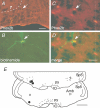Inhibitory input from slowly adapting lung stretch receptors to retrotrapezoid nucleus chemoreceptors
- PMID: 17255166
- PMCID: PMC2075437
- DOI: 10.1113/jphysiol.2006.125336
Inhibitory input from slowly adapting lung stretch receptors to retrotrapezoid nucleus chemoreceptors
Abstract
The retrotrapezoid nucleus (RTN) contains CO(2)-activated interneurons with properties consistent with central respiratory chemoreceptors. These neurons are glutamatergic and express the transcription factor Phox2b. Here we tested whether RTN neurons receive an input from slowly adapting pulmonary stretch receptors (SARs) in halothane-anaesthetized ventilated rats. In vagotomized rats, RTN neurons were inhibited to a variable extent by stimulating myelinated vagal afferents using the lowest intensity needed to inhibit the phrenic nerve discharge (PND). In rats with intact vagus nerves, RTN neurons were inhibited, also to a variable extent, by increasing positive end-expiratory pressure (PEEP; 2-6 cmH(2)O). The cells most sensitive to PEEP were inhibited during each lung inflation at rest and were instantly activated by stopping ventilation. Muscimol (GABA-A agonist) injection in or next to the solitary tract at area postrema level desynchronized PND from ventilation, eliminated the lung inflation-synchronous inhibition of RTN neurons and their steady inhibition by PEEP but did not change their CO(2) sensitivity. Muscimol injection into the rostral ventral respiratory group eliminated PND but did not change RTN neuron response to either lung inflation, PEEP increases, vagal stimulation or CO(2). Generalized glutamate receptor blockade with intracerebroventricular (i.c.v.) kynurenate eliminated PND and the response of RTN neurons to lung inflation but did not change their CO(2) sensitivity. PEEP-sensitive RTN neurons expressed Phox2b. In conclusion, RTN chemoreceptors receive an inhibitory input from myelinated lung stretch receptors, presumably SARs. The lung input to RTN may be di-synaptic with inhibitory pump cells as sole interneurons.
Figures








Comment in
-
Reflexively inhibiting respiratory drive.J Physiol. 2007 Apr 1;580(Pt 1):3. doi: 10.1113/jphysiol.2007.130500. Epub 2007 Feb 22. J Physiol. 2007. PMID: 17317738 Free PMC article. No abstract available.
Similar articles
-
Activation of 5-hydroxytryptamine type 3 receptor-expressing C-fiber vagal afferents inhibits retrotrapezoid nucleus chemoreceptors in rats.J Neurophysiol. 2007 Dec;98(6):3627-37. doi: 10.1152/jn.00675.2007. Epub 2007 Oct 10. J Neurophysiol. 2007. PMID: 17928558
-
GABAergic pump cells of solitary tract nucleus innervate retrotrapezoid nucleus chemoreceptors.J Neurophysiol. 2007 Jul;98(1):374-81. doi: 10.1152/jn.00322.2007. Epub 2007 Apr 25. J Neurophysiol. 2007. PMID: 17460107
-
Peripheral chemoreceptor inputs to retrotrapezoid nucleus (RTN) CO2-sensitive neurons in rats.J Physiol. 2006 Apr 15;572(Pt 2):503-23. doi: 10.1113/jphysiol.2005.103788. Epub 2006 Feb 2. J Physiol. 2006. PMID: 16455687 Free PMC article.
-
The retrotrapezoid nucleus and breathing.Adv Exp Med Biol. 2012;758:115-22. doi: 10.1007/978-94-007-4584-1_16. Adv Exp Med Biol. 2012. PMID: 23080151 Free PMC article. Review.
-
The 2008 Carl Ludwig Lecture: retrotrapezoid nucleus, CO2 homeostasis, and breathing automaticity.J Appl Physiol (1985). 2008 Aug;105(2):404-16. doi: 10.1152/japplphysiol.90452.2008. Epub 2008 Jun 5. J Appl Physiol (1985). 2008. PMID: 18535135 Free PMC article. Review.
Cited by
-
Differential Contribution of the Retrotrapezoid Nucleus and C1 Neurons to Active Expiration and Arousal in Rats.J Neurosci. 2020 Nov 4;40(45):8683-8697. doi: 10.1523/JNEUROSCI.1006-20.2020. Epub 2020 Sep 24. J Neurosci. 2020. PMID: 32973046 Free PMC article.
-
Inhibition of the hypercapnic ventilatory response by adenosine in the retrotrapezoid nucleus in awake rats.Neuropharmacology. 2018 Aug;138:47-56. doi: 10.1016/j.neuropharm.2018.05.029. Epub 2018 May 23. Neuropharmacology. 2018. PMID: 29857188 Free PMC article.
-
An interdependent model of central/peripheral chemoreception: evidence and implications for ventilatory control.Respir Physiol Neurobiol. 2010 Oct 31;173(3):288-97. doi: 10.1016/j.resp.2010.02.015. Epub 2010 Mar 4. Respir Physiol Neurobiol. 2010. PMID: 20206717 Free PMC article. Review.
-
Independent purinergic mechanisms of central and peripheral chemoreception in the rostral ventrolateral medulla.J Physiol. 2015 Mar 1;593(5):1067-74. doi: 10.1113/jphysiol.2014.284430. Epub 2015 Jan 22. J Physiol. 2015. PMID: 25524282 Free PMC article. Review.
-
Anesthetic activation of central respiratory chemoreceptor neurons involves inhibition of a THIK-1-like background K(+) current.J Neurosci. 2010 Jul 7;30(27):9324-34. doi: 10.1523/JNEUROSCI.1956-10.2010. J Neurosci. 2010. PMID: 20610767 Free PMC article.
References
-
- Akilesh MR, Kamper M, Li A, Nattie EE. Effects of unilateral lesions of retrotrapezoid nucleus on breathing in awake rats. J Appl Physiol. 1997;82:469–479. - PubMed
-
- Bodineau L, Frugière A, Marlot D, Wallois F. Connections between retrotrapezoid nucleus and nucleus tractus solitarii in cat. Neurosci Lett. 2000a;280:111–114. - PubMed
-
- Bodineau L, Frugiere A, Marlot D, Wallois F. Effect of hypoxia on the activity of respiratory and non-respiratory modulated retrotrapezoid neurons of the cat. Auton Neurosci. 2000b;86:70–77. - PubMed
-
- Coleridge HM, Coleridge JC. Afferent innervation of lungs, airways, and pulmonary artery. In: Zucker IH, Gilmore JP, editors. Reflex Control of the Circulation. Boca Raton: CRC Press; 2001. pp. 579–607.
-
- Connelly CA, Ellenberger HH, Feldman JL. Respiratory activity in retrotrapezoid nucleus in cat. Am J Physiol. 1990;258:L33–L44. - PubMed
Publication types
MeSH terms
Substances
Grants and funding
LinkOut - more resources
Full Text Sources
Other Literature Sources
Miscellaneous

